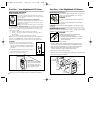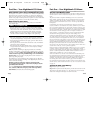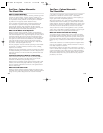
Part Three – What You Should Know
Before the Alarms Sounds
The maximum allowable concentration for con-
tinuous exposure for healthy adults in any
8-hour period, according to OSHA*.
Slight headache, fatigue, dizziness, nausea
after 2-3 hours.
Frontal headaches within 1-2 hours, life threat-
ening after 3 hours.
Dizziness, nausea and convulsions within 45
minutes. Unconsciousness within 2 hours. Death
within 2-3 hours.
Headache, dizziness and nausea within 20 min-
utes. Death within 1 hour.
Headache, dizziness and nausea within 5-10
minutes. Death within 25-30 minutes.
Headache, dizziness and nausea within 1-2 min-
utes. Death within 10-15 minutes.
Death within 1-3 minutes.
50 ppm
200 ppm
400 ppm
800 ppm
1,600 ppm
3,200 ppm
6,400 ppm
12,800 ppm
Concentration
of CO in Air
(ppm = parts
per million)
Approximate Inhalation Time
and Symptoms Developed
* Occupational Safety and Health Administration
Part Three – What You Should Know
Before the Alarms Sounds
Learn the difference between dangerous levels,
high levels, mid levels and low levels:
Dangerous levels, when someone is experiencing symptoms of
CO poisoning and CO readings are generally above 100 ppm.
Anytime someone is experiencing the symptoms of carbon monoxide
poisoning this should be treated as an EMERGENCY. Follow the instruc-
tions on page 4-2.
High levels, generally above 100 ppm, with no one experiencing
symptoms. This should be treated as an URGENT situation. Follow the
instructions on page 4-2.
Mid levels, generally between 50 ppm to 100 ppm. This should be
cause for CONCERN and should not be ignored or dismissed. Follow
the instructions on page 4-2.
Low levels, generally below 50 ppm. This indicates a need to watch
the situation closely to see if it resolves itself or worsens. Follow the
instructions on page 4-3.
Determine if anyone in the household is at high risk
for CO poisoning:
Many cases of reported carbon monoxide poisoning indicate that while
victims are aware they are not well, they become so disoriented they are
unable to save themselves by either exiting the building or calling for
assistance.
You should take extra precautions to protect high risk persons from
CO exposure because they may experience ill effects from carbon monox-
ide at levels that would not ordinarily affect a healthy adult. Are there any
infants or small children in the home? Be sure to check them for signs of
possible CO poisoning because they might have trouble explaining their
symptoms. Infants and children are more susceptible to CO poisoning
than a healthy adult.
Pregnant women should be aware that their unborn fetus could be
harmed by exposure to carbon monoxide, even when the mother suffers
no ill effect herself. Any pregnant woman who suspects she may have
been exposed to carbon monoxide should immediately contact her
physician.
Is there anyone in the household who is elderly, or who has anemia,
heart disease or respiratory problems, emphysema or chronic bronchitis?
These individuals are at higher risk for CO poisoning and for health
problems from exposure to low levels of carbon monoxide.
If anyone in the household is at high risk for CO poisoning, we urge you
to take extra precaution to prevent possible poisoning. If the unit alarms
or if CO readings are shown on the digital display, remove the at-risk
person from the premises, if possible. Ventilate the area. The high-risk
person(s) should not re-enter the residence until the source of the CO
problem has been identified and corrected.
Understand the Effects of Carbon Monoxide Exposure
Low Levels:
Generally 50 ppm and below.
High Levels:
Generally 100 ppm and above
if no one is experiencing
symptoms.
Mid Levels:
Generally 50 ppm to 100 ppm.
Dangerous Levels:
Generally 100 ppm and above if
someone is experiencing symptoms.
Reminder: The chart above relates to the exposure of healthy adults.
Read the info on the previous page for descriptions of those who are at
higher risk.
3-2
3-1
810-1009 AC Digital 11/13/01 11:22 AM Page 26


















